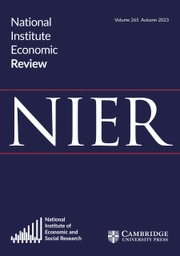No CrossRef data available.
Article contents
INTRODUCTION TO THE SPECIAL ISSUE ON ‘CURRENT ISSUES IN CENTRAL BANKING’
Published online by Cambridge University Press: 20 May 2025
Abstract
The recent surge in inflation has led to an increase in research by academic economists into various aspects of central banking: in particular, central bank communication and trust in central banks. In addition, the move towards introducing Central Bank Digital Currency has increased the need for research in this area. This Special Issue of the National Institute Economic Review brings together some of this recent research and includes contributions from academic and policy-oriented researchers and leading experts on these recent developments in central banking research.
Keywords
Information
- Type
- Notes and Contributions
- Information
- National Institute Economic Review , Volume 269: Special issue: CURRENT ISSUES IN CENTRAL BANKING , Autumn 2024 , pp. 1 - 3
- Copyright
- © The Author(s), 2025. Published by Cambridge University Press on behalf of National Institute Economic Review

